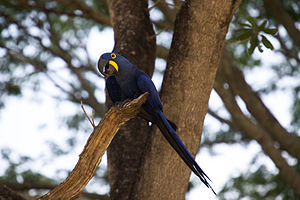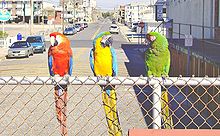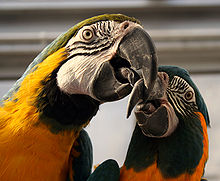- Macaw
-
Macaw 
A Hyacinth Macaw in the Pantanal, Mato Grosso, Brazil Scientific classification Kingdom: Animalia Phylum: Chordata Class: Aves Order: Psittaciformes Family: Psittacidae Subfamily: Psittacinae Tribe: Arini Genera Ara
Anodorhynchus
Cyanopsitta
Primolius
Orthopsittaca
DiopsittacaMacaws are small to large, often colourful New World parrots. Of the many different Psittacidae (true parrots) genera, six are classified as macaws: Ara, Anodorhynchus, Cyanopsitta, Primolius, Orthopsittaca, and Diopsittaca. Previously, the members of the genus Primolius were placed in Propyrrhura, but the former is correct in accordance with ICZN rules.[1] Macaws are native to Mexico, Central America, South America, and formerly the Caribbean. Most species are associated with forests, especially rainforests, but others prefer woodland or savannah-like habitats.[2]
Large, dark (usually black) beaks, and relatively bare, light coloured, medial (facial patch) areas distinguish macaws. Sometimes the facial patch is smaller in some species, and limited to a yellow patch around the eyes and a second patch near the base of the beak in the members of the genus Anodorhynchus, or Hyacinth Macaw. A macaw's facial feather pattern is as unique as a fingerprint.[3]
Some of the macaw species are known for their impressive size. The largest parrot in length and wingspan is the Hyacinth Macaw. The heaviest macaw is the Buffon's, although the heaviest parrot is the flightless Kakapo. While still relatively large parrots, the macaws of the genera Cyanopsitta, Orthopsittaca and Primolius are significantly smaller than the members of Anodorhynchus and Ara. The smallest member of the family, the Red-shouldered Macaw, is no larger than some parakeets of the genus Aratinga.[2]
Macaws, like other parrots, toucans and woodpeckers, are zygodactyl, having their first and fourth toes pointing backwards.[2]
Contents
Species in taxonomic order
There are 18 species of Macaws, including extinct and critically endangered species.[4] In addition, there are several hypothetical extinct species that have been proposed based on very little evidence.[5]
- Anodorhynchus
- Glaucous Macaw, Anodorhynchus glaucus (critically endangered or extinct)
- Hyacinth Macaw, Anodorhynchus hyacinthinus
- Indigo Macaw or Lear's Macaw, Anodorhynchus leari
- Cyanopsitta
- Little Blue Macaw or Spix's Macaw, Cyanopsitta spixii (extinct in the wild)
- Ara
- Blue-and-yellow Macaw or Blue-and-gold Macaw, Ara ararauna
- Blue-throated Macaw, Ara glaucogularis
- Military Macaw, Ara militaris
- Buffon's Macaw or Great Green Macaw, Ara ambiguus
- Scarlet Macaw or Aracanga, Ara macao
- Green-winged Macaw, Ara chloroptera
- Red-fronted Macaw, Ara rubrogenys
- Chestnut-fronted Macaw or Severe Macaw, Ara severa
- †Cuban Red Macaw, Ara tricolor (extinct)
- †Saint Croix Macaw, Ara autochthones[6] (extinct)
- Orthopsittaca
- Red-bellied Macaw, Orthopsittaca manilata
- Primolius
- Blue-headed Macaw, Primolius couloni
- Illiger's Macaw or Blue-winged Macaw, Primolius maracana
- Golden-collared Macaw, Primolius auricollis
- Diopsittaca
- Red-shouldered Macaw or Hahn's Macaw, Diopsittaca nobilis
Hypothetical extinct species
Several hypothetical extinct species of macaws have been postulated based on very little evidence, and they may have been subspecies, or familiar parrots that were imported onto an Island and later presumed to have a separate identity.[5]
- Martinique Macaw, Ara martinica, Rothschild 1905
- Red-tailed Blue-and-yellow Macaw, Ara erythrura, Rothschild 1907
- Lesser Antillean Macaw, Ara guadeloupensis, Clarke, 1905
- Jamaican Green-and-yellow Macaw, Ara erythrocephala, Rothschild 1905
- Jamaican Red Macaw, Ara gossei, Rothschild 1905
- Dominican Green-and-yellow Macaw, Ara atwoodi, Clarke, 1905
- Oné Couli, Anodorhynchus purpurascens
Extinctions and conservation status
The majority of macaws are now endangered in the wild. Six species are already extinct, and Spix's Macaw is now considered to be extinct in the wild. The Glaucous Macaw is also probably extinct, with only two reliable records of sightings in the 20th century. The greatest problems threatening the macaw population are the rapid rate of deforestation and the illegal trapping for the bird trade.[7]
International trade of all macaw species is regulated by the Convention on International Trade in Endangered Species of Wild Flora and Fauna (CITES). Some species of macaws for example, the Scarlet Macaw (Ara macao) are listed on Appendix I and may not be traded for commercial purposes. Other species for example, the Red-Shouldered Macaw (Diopsittaca nobilis) are listed on Appendix II and may be legally traded commercially provided that certain controls are in place. The controls include a non-detriment finding, establishment of an export quota and issuing of export permits.
Hybrids
A common trend in more recent years is hybridising macaws for the pet trade. Hybrids are typical macaws, with the only difference from true species being their genetics and their colours. Male offspring tend to take on the traits of the mother, and the females take the traits of the father.[citation needed]
Aviculturists have reported an over abundance of female blue and gold macaws in captivity, which differs from the general rule with captive macaws and other parrots, where the males are more abundant.[citation needed] This would explain why the blue and gold is the most commonly hybridised macaw, and why the hybridising trend took hold among macaws. Common macaw hybrids include Harlequins (Ara ararauna x chloroptera) and Catalinas (known as Rainbows in Australia, A. ararauna x macao). In addition, unusual but apparently healthy intergeneric hybrids between the Hyacinth Macaw and several of the larger Ara macaws have occasionally arisen in captivity.[8]
Diet and clay licks
Macaws eat a variety of foods including fruits, palm fruits, nuts, seeds, leaves, flowers, and stems. Wild species may forage widely, over 100 km (62 mi) for some of the larger species such as Ara araurana (blue & yellow macaw) and Ara ambigua (great green macaw), in search of seasonally available foods. Some foods eaten by macaws in the wild contain toxic or caustic substances which they are able to digest. It has been suggested that parrots and macaws in the Amazon basin eat clay from exposed river banks to neutralize these toxins.[9] In the western Amazon hundreds of macaws and other parrots descend to exposed river banks to consume clay on an almost daily basis[10] - except on rainy days.[11]
Donald Brightsmith, the principal investigator of the Tambopata Macaw Project, located at the Tambopata Research Center (TRC) in Peru, has studied the clay eating behavior of parrots at clay licks in Peru. He and fellow investigators found that the soils macaws choose to consume at the clay licks do not have higher levels of cation exchange capacity (ability to adsorb toxins) than that of unused areas of the clay licks[12] and thus the parrots could not be using the clay to neutralize ingested food toxins. Rather, the macaws and other bird and animal species prefer clays with higher levels of sodium.[13] Sodium is a vital element that is scarce in environments >100 kilometers from the ocean.[14] The distribution of claylicks across South America further supports this hypothesis - as the largest and most species rich claylicks are found on the western side of the Amazon basin far from oceanic influences.[15] Salt-enriched (NaCl) oceanic aerosols are the main source of environmental sodium near coasts and this decreases drastically farther inland.[16]
Clay-eating behavior by macaws is not seen outside the western Amazon region even though macaws in these areas consume toxic foods such as the seeds of Hura crepitans, or sandbox tree, which have toxic sap. Species of parrot that consume more seeds, which potentially have more toxins, do not use claylicks more than species that eat a greater proportion of flowers or fruit in their diets.[16]
Studies at TRC have shown a correlation between clay lick use and breeding season.[17] Contents of nestling crop samples show a high percentage of clay fed to them by their parents. Calcium for egg development - another hypothesis - does not appear to be a reason for geophagy during this period as peak usage is after the hatching of eggs.
Gallery
-
Military Macaw (Ara militaris)
-
Wing clipped Scarlet Macaws
References
- ^ South American Classification Committee To reassign the genus of three macaws.
- ^ a b c Abramson, J., Speer, B. L., & Thomsen, J.B. 1999, "The Large Macaws, Their Care and Breeding", Raintree Publications:CA
- ^ "Facial fingerprint: http://webparrots.com". http://webparrots.com/blue_and_gold_macaw.html.
- ^ "Zoological Nomenclature Resource: Psittaciformes (Version 9.004)". www.zoonomen.net. 2008-07-05. http://www.zoonomen.net/avtax/psit.html.
- ^ a b Fuller, Errol (1987). Extinct Birds. Penguin Books (England). pp. 148–9. ISBN 0670817972.
- ^ Wetmore, A. (1937). "Ancient records of birds from the island of St. Croix with observations on extinct and living of Puerto Rico.". J. Agric. Univ. Puerto Rico 21: 5–16.
- ^ Snyder, N., McGowan, P., Gilardi, J. & Grajal, A. (Eds.) 2000. Parrots. Status Survey and Conservation Action Plan 2000–2004, Gland, Switzerland, and Cambridge, UK, IUCN.
- ^ Macaws, Hybrid Names, and pages on individual hybrids.
- ^ Gilardi, J. D. 1996. Ecology of parrots in the Peruvian Amazon: Habitat use, nutrition, and geophagy. Ph.D. dissertation. University of California at Davis, Davis, California
- ^ Munn, C. A. 1994. Macaws: winged rainbows. National Geographic, 185, 118-140.
- ^ Brightsmith, D. J. 2004. Effects of weather on parrot geophagy in Tambopata, Peru. Wilson Bulletin, 116, 134-145.
- ^ Brightsmith & Muñoz-Najar. 2004. Avian Geophagy and Soil Characteristics in Southeastern Peru. Biotropica 36(4): 534-543.
- ^ Powell et al. 2009. Parrots Take it with a Grain of Salt: Available Sodium Content May Drive Collpa (Clay Lick) Selection in Southeastern Peru. Biotropica 41(3):279-282.
- ^ On the biogeography of salt limitation
- ^ Lee et al. 2010. Claylick distribution in South America - do patterns of where help answer the question why? Ecography 33: 503–513
- ^ a b Lee, A.T.K. 2010. Parrot Claylicks: Distribution, Patterns Of Use And Ecological Correlates From A Parrot Assemblage In Southeastern Peru, PhD Dissertation, Manchester Metropolitan University Parrots and claylicks dissertation
- ^ Brightsmith, D. J. 2006. The psittacine year: what drives annual cycles in Tambopata's parrots? Proceedings of the Loro Parque International Parrot Symposium, Tenerife, Spain. [1]
External links
- Macaws Macaw care
- Macaws at the Open Directory Project
- ParrotScience - parrot information site
- San Diego Zoo Animal Bytes: Macaw
- Gigapan photo of a macaw clay lick
- Tambopata Macaw Project
Macaws Genus Species (extinctions: † indicates a species confirmed to be extinct, ₴ indicates evidence only from sub-fossils)Anodorhynchus Cyanopsitta Ara Blue-and-yellow Macaw (or Blue-and-gold Macaw) • Blue-throated Macaw • Military Macaw • Great Green Macaw (or Buffon's Macaw) • Scarlet Macaw • Red-and-green Macaw (or Green-winged Macaw) • Red-fronted Macaw • Chestnut-fronted Macaw (or Severe Macaw) • Cuban Red Macaw † • Saint Croix Macaw † ₴Orthopsittaca Primolius Diopsittaca Hypothetical extinct macaws
(unconfirmed genus)Categories:- Macaws
- Anodorhynchus
Wikimedia Foundation. 2010.







